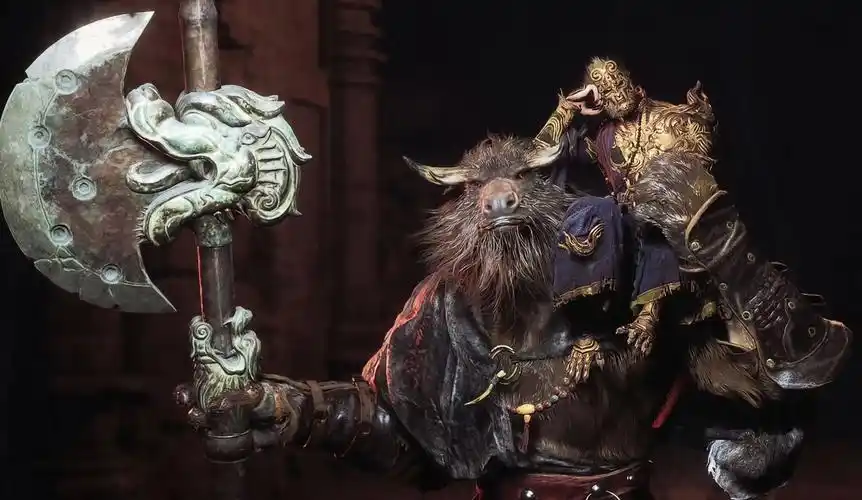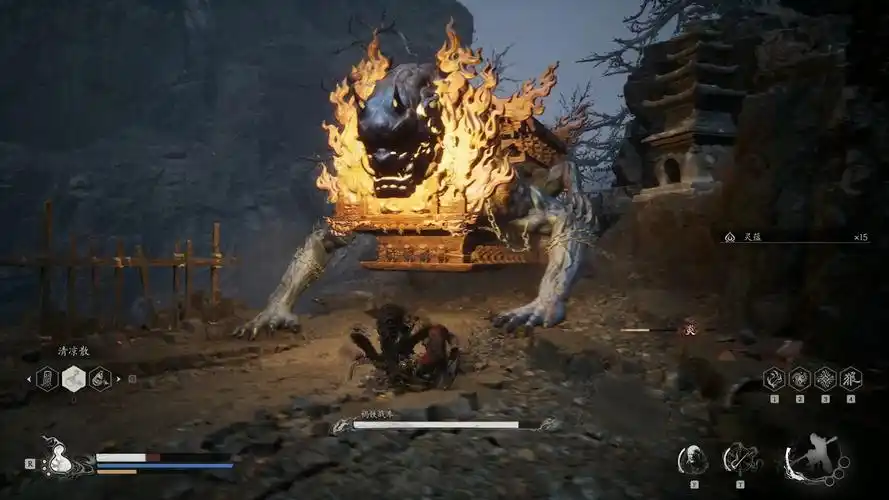In this episode, the Destined One arrives at the Woods of Ember, where he encounters various Yaoguai such as Pale-Axe Stalwart, Brown-Iron Cart, and Father of Stones. In this text, we will first discuss Pale-Axe Stalwart and Brown-Iron Cart.
After defeating the Hundred-Eyed Daoist Master at the Temple of Yellow Flowers and obtaining the Envious Tongue, the Destined One already possesses four of the Great Sage’s Root Instruments. Learning that the fifth Root Instrument is in the hands of the Bull King, the Destined One and Zhu Bajie immediately rush towards the Flaming Mountains. Upon entering the Woods of Ember in the Flaming Mountains, Zhu Bajie transforms into a gigantic wild boar, sweeping through the Ghost Soldiers and Ghost Generals alongside the Destined One. Subsequently, Zhu Bajie goes ahead to scout the path. Meanwhile, the Destined One, while fighting alone, rescues Pale-Axe Stalwart, a vanguard of the Bull King’s forces who was surrounded by enemies.
Mountains, Zhu Bajie transforms into a gigantic wild boar, sweeping through the Ghost Soldiers and Ghost Generals alongside the Destined One. Subsequently, Zhu Bajie goes ahead to scout the path. Meanwhile, the Destined One, while fighting alone, rescues Pale-Axe Stalwart, a vanguard of the Bull King’s forces who was surrounded by enemies.
Pale-Axe Stalwart, one of the sworn brothers sent by Erlang, the Sacred Divinity, to test the Destined One, is also one of the brothers from Mount Mei. According to the game’s description and deductions from “The Investiture of the Gods,” the first chapter’s Whiteclad Noble is Chang Hao (Snake Guai), one of the Six Saints of Mount Mei; the second chapter’s Yellow-Robed Squire is Zhu Zi Zhen (Pig Guai); the third chapter’s Green-Capped Martialist is Yang Xian (Sheep Guai); the fourth chapter’s Venom Daoist is Wu Long (Centipede Guai); and the fifth chapter’s Pale-Axe Stalwart is Jin Da Sheng (Bull Guai).
From Pale-Axe Stalwart’s mouth, we learn that the Flaming Mountains are now in chaos. The mountain passes are blocked by the Five Elements Chariots, making it difficult to meet the Bull King. In “Journey to the West,” the Five Elements Chariots are ritual implements refined by Red Boy, and in “Black Myth: Wukong,” it is elaborated that they became formidable Yaoguai in the Flaming Mountains due to being imbued with spiritual energy from Red Boy’s Samadhi True Fire. So, what exactly are these chariots described in the game?
The chariot was one of the most important pieces of military equipment in ancient China, playing a crucial role especially during the Shang Dynasty and Western Zhou period through to the Spring and Autumn and Warring States periods. As an early form of military technology, the chariot had multiple uses, including command, reconnaissance, raids, and frontal assaults. Ancient chariots, used in battle, were horse-drawn combat vehicles, typically single-axle and two-wheeled, with a square carriage driven by either four or two horses. A typical chariot crew consisted of three armored warriors: the charioteer in the middle responsible for driving, called the “driver,” a left-side archer tasked with long-range shooting, and a right-side soldier for close-quarters combat.
Initially, chariots were two-wheeled with solid wooden wheels; later developments introduced spoked wheels to reduce weight and increase maneuverability. The carriage was usually rectangular or semi-circular, mounted above the axle, with a front shield to protect the occupants. Typically pulled by two to four horses, the harness included yokes and reins, with the driver controlling the horses through the reins.
Chariots had a strong impact when used on flat terrain, capable of quickly penetrating enemy lines and disrupting formations. Due to the elevated position of the chariot, its occupants had a clear view of the battlefield, which was advantageous for commanding and relaying orders. Chariots could quickly move across the battlefield for reconnaissance and rapid response.
Chariots first appeared during the Shang Dynasty and were widely used throughout the Western Zhou period. They remained the primary combat tool, but with the evolution of infantry tactics, their importance gradually declined. During the Warring States period, regions like the state of Qin began to emphasize infantry and cavalry, gradually reducing the use of chariots. With the rise of cavalry and advancements in crossbow technology in the subsequent Qin and Han periods, chariots were eventually phased out. In ancient times, chariots were not only tools of war but also symbols of nobility status. Nobles who owned chariots often held high social status. Chariots were also used in various ceremonial and ritual activities, symbolizing power and authority.
In the game, the Five Elements Chariot is the boss of the Flaming Mountains, consisting of the Brown-Iron Cart, Gray-Bronze Cart, Crimson-Silver Cart, Rusty-Gold Cart, and another cart that was destroyed along with Ma Tianba.
The names of four of the Five Elements Chariots are Brown-Iron, Gray-Bronze, Crimson-Silver, and Rusty-Gold, indicating that the names are a combination of a color and a metal. Following this pattern, the missing chariot’s name likely includes “Tin.” As for the color, according to the Five Elements theory, brown represents earth, gray represents water, crimson represents fire, and rusty represents metal. Thus, it’s reasonable to deduce that the remaining chariot’s color should be chosen from those representing wood, which includes green, blue, turquoise, pink, etc. Therefore, it is highly probable that it is called the Green-Tin Chariot.
